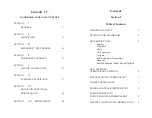
Pilot Operating Handbook
Cavalon
SECTION 8
HANDLING / MAINTENANCE
AutoGyro_POH_Cavalon 915iS
Revision 1.0 – Issue Date 08.MAY.2019
8-1
SECTION 8 - HANDLING AND SERVICING
This chapter contains guidelines for correct handling and servicing of the gyroplane, as well
as manufacturer recommendations helping to keep its performance, reliability and value.
8.1
Maintenance Obligations
The owner/operator is responsible to ensure that the aircraft is kept in an airworthy
condition. With respect to continued airworthiness, manufacturer requirements and
regulations from your competent aviation administration (for example annual airworthiness
inspection) need to be complied with.
All airworthiness limitations, inspections and time limits are described in detail in the Aircraft
Maintenance Manual. However, for owner/operator’s information the intervals for mandatory
maintenance events are provided as follows:
25 hrs: “25 hrs inspection” (one-time / non-recurrent)
100 hrs / 12 months (whatever occurs first): “100 hrs inspection”
12 months/ Annual airworthiness review (if or as required by a relevant organisation)
For engine maintenance and overhaul, refer to the engine manufacturer’s manual.
Special inspections have to be performed by an authorized and qualified maintenance
centre or the manufacturer after operational incidents, which are
Suspected hard landing
Rotor contact with obstacle
Propeller contact with obstacle or external impact
Bird strike
Lightning strike
If any of the above cases apply, mark the aircraft as ‘unserviceable’ and consult the
manufacturer or an authorized maintenance and repair station before further operation.
Apart from these obligatory inspections and maintenance tasks, the owner/operator is
entitled to perform the following preventive and in-between maintenance tasks and checks,
as well as exchange of parts and minor repairs:
8.2
General
Whenever possible, park the gyroplane in a place where it is protected from direct sunlight,
wind and humidity. High humidity, especially in combination with a salt-laden atmosphere
will lead to corrosion and/or composite structure paint blisters. The sunlight’s ultra-violet
radiation and the heat impact on the GRP/CRP components may lead to a degradation of
the materials integrity. The manufacturer will take no responsibility for damage or impaired
safety margin due to improper treatment.






































